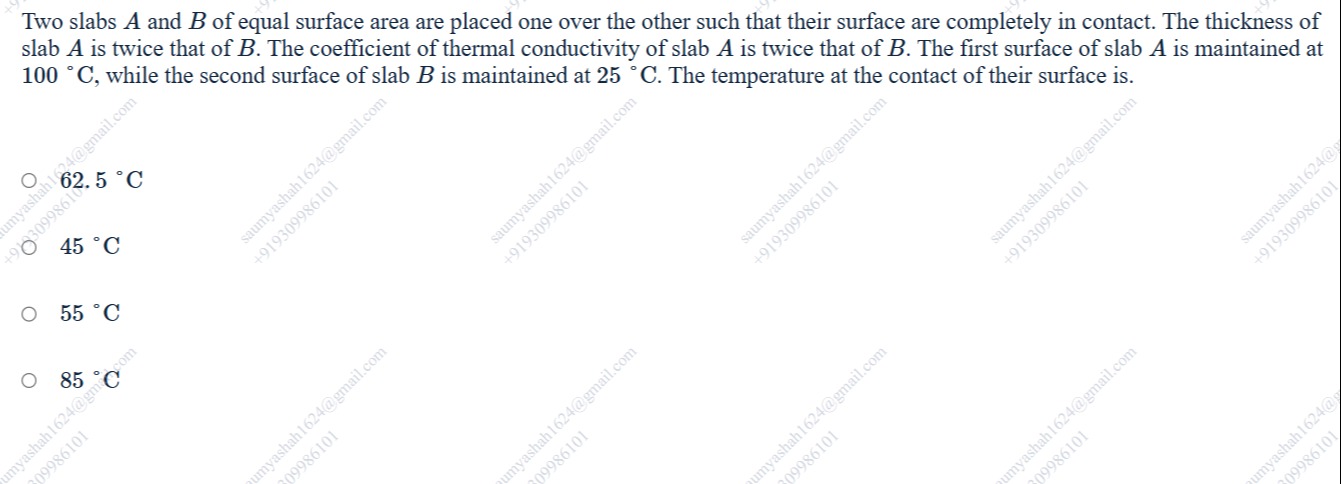Question
Question: Two slabs $A$ and $B$ of equal surface area are placed one over the other such that their surface ar...
Two slabs A and B of equal surface area are placed one over the other such that their surface are completely in contact. The thickness of slab A is twice that of B. The coefficient of thermal conductivity of slab A is twice that of B. The first surface of slab A is maintained at 100 ∘C, while the second surface of slab B is maintained at 25 ∘C. The temperature at the contact of their surface is.

62.5 ∘C
45 ∘C
55 ∘C
85 ∘C
62.5 ∘C
Solution
Let LA and LB be the thicknesses of slabs A and B, respectively, and KA and KB be their thermal conductivities. Let A be the surface area of each slab. We are given that LA=2LB and KA=2KB. The first surface of slab A is maintained at T1=100 ∘C, and the second surface of slab B is maintained at T2=25 ∘C. Let Ti be the temperature at the contact surface between slabs A and B.
In the steady state, the rate of heat transfer through slab A is equal to the rate of heat transfer through slab B. The rate of heat transfer through a slab is given by Fourier's law of conduction: Q=LKAΔT.
For slab A, the temperature difference is T1−Ti. The heat flow rate through slab A is QA=LAKAA(T1−Ti).
For slab B, the temperature difference is Ti−T2. The heat flow rate through slab B is QB=LBKBA(Ti−T2).
Since the slabs are in series and in steady state, QA=QB.
LAKAA(T1−Ti)=LBKBA(Ti−T2)
Substitute the given relationships LA=2LB and KA=2KB:
2LB(2KB)A(100−Ti)=LBKBA(Ti−25)
The term 2LB2KBA simplifies to LBKBA. So the equation becomes:
LBKBA(100−Ti)=LBKBA(Ti−25)
Assuming KB=0, A=0, and LB=0, we can cancel the term LBKBA from both sides:
100−Ti=Ti−25
Now, we solve for Ti:
100+25=Ti+Ti
125=2Ti
Ti=2125
Ti=62.5 ∘C
Alternatively, we can use the concept of thermal resistance. The thermal resistance of a slab is R=KAL.
For slab A, RA=KAALA=(2KB)A2LB=KBALB.
For slab B, RB=KBALB.
We observe that RA=RB.
When two thermal resistances are in series, the temperature drop across each resistance is proportional to its value. The heat flow rate is Q=RΔT.
Q=RAT1−Ti=RBTi−T2.
Since RA=RB, we have RAT1−Ti=RATi−T2, which implies T1−Ti=Ti−T2.
T1+T2=2Ti
Ti=2T1+T2
Substitute the values T1=100 ∘C and T2=25 ∘C:
Ti=2100+25=2125=62.5 ∘C.
The temperature at the contact of their surface is 62.5 ∘C.
